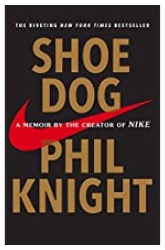Nike is one of our most iconic brands. It is one with which we are all intimately familiar.
The company is an American success story by any measurement. In 2019, it is 344th on Forbes’ Global 2000. It is also ranked as the 49th World’s Best employer and the 39th top regarded company. In the rankings of America’s largest companies, it is 143rd in profits, 81st in sales and 45th in market value.[1]
What about the logo and what it represents in the mind of the consumer?
Interbrand ranked Nike as #17 in its Best Global Brands 2018 Ranking. Forbes’ ranked Nike as #18 in its list of Worlds Most Valuable Brands. A study by Seigel+Gate found that Nike was number one in the US and UK when participants were asked to “describe the logos that they found most memorable”
But it wasn’t always this way. The story of the first Nikes and the Nike Swoosh logo are remarkable in light of Nike’s domination of the shoe market.
This is the story of the swoosh.

The Back Story
Phil Knight had been selling Japanese Tiger running shoes since 1964. His small company, Blue Ribbon, had grown steadily every year, but so far, Phil had not been able to be a full time employee. He just couldn’t afford to pay himself a salary.
So, he worked as a CPA to support himself and then, in order to free up more time, he took a job teaching accounting at Portland State. It was 1969, and Phil was ready to go full-time at Blue Ribbon. Before he left the campus, he met a student artist. Her name was Carolyn Davidson. Knight offered her $2 an hour to produce some artwork. Over the next few years, Carolyn produced a few marketing brochures.
In 1971, circumstances changed abruptly. Onitsuka, the Japanese company that produced Tigers, wanted to take over Blue Ribbon. Knight’s supplier would either own his company or find new suppliers. Either way, Knight would find himself cut out.
Knight realized that he was at their mercy. He was totally dependent on them for his shoes. So, Knight found a new factory in Mexico and he produced his own athletic shoes.
Knight designed the shoes easily enough. He had spent nearly a decade in the industry. He knew what worked and what didn’t work. But when he was asked about the logo. He was stumped.
Swoosh
He asked carol to create a logo: “Something that evokes a sense of motion.”[2] Here is what happened in his own words:
Two weeks later she came back with a portfolio of rough sketches. They were all variations on a single theme, and the theme seemed to be . . . fat lightning bolts? Chubby check marks? Morbidly obese squiggles? Her designs did evoke motion, of a kind, but also motion sickness. None spoke to me. I singled out a few that held out some promise and asked her to work with those….
Gradually we inched toward a consensus. We liked . . . this one . . . slightly more than the others.
It looks like a wing, one of us said.
It looks like a whoosh of air, another said.
It looks like something a runner might leave in his or her wake.
We all agreed it looked new, fresh, and yet somehow—ancient. Timeless.
For her many hours of work, we gave Carolyn our deepest thanks and a check for thirty-five dollars, then sent her on her way.
After she left we continued to sit and stare at this one logo, which we’d sort of selected, and sort of settled on by default. “Something eye-catching about it,” Johnson said. Woodell agreed. I frowned, scratched my cheek. “You guys like it more than I do,” I said. “But we’re out of time. It’ll have to do.”[3]
As you know, the Nike swoosh was a big hit, but no one could foresee what happen when they were first produced. When the first Nikes were introduced at a trade show, salesmen who had never seen a shoe with the swoosh wanted to know what the symbol was. Knight answered, “That’s a swoosh.” When they asked what a swoosh was, Knight responded: “It’s the sound of someone going past you.”[4]
They placed orders.
Afterward
In 1983, the founders of Nike invited Carolyn Davis to lunch and presented her with a gold ring in the shape of a swoosh. They also gave her 500 shares of shares of Nike stock which is worth about $680,000 today.[5][6]
What about you?
In the last lesson, I told you that overnight successes often take 20 year. The swoosh was created forty-eight years ago. What are you doing now to lay the foundation for success you will reap decades from now?
References
[1] #344 Nike (2018). Forbes 2000. Retrieved from https://www.forbes.com/companies/nike/?list=global2000#2a4ed7626eb5
[2] Knight, P. (2016). Shoe Dog: A memoir from the creator of Nike. New York: Scribner.
(p. 180).
[3] Knight, P. (2016). Shoe Dog: A memoir from the creator of Nike. New York: Scribner. (p. 182).
[4] Knight, P. (2016). Shoe Dog: A memoir from the creator of Nike. New York: Scribner.
(p. 202).
[5] Howard, B.C. (2011, June 16). ‘I never get tired of looking at it’: Woman who designed Nike’s swoosh explains how chance encounter with Phil Knight led to its inception 40 years ago. DailyMail.com. Retrieved from https://www.dailymail.co.uk/news/article-2004273/Woman-designed-Nike-swoosh-explains-story-inception-40-years-ago.html
[6] Note: The original article gave a figure of $643,035 in 2011. By my calculations, her 500 shares are now worth $683,120. According to the article, she never sold her shares.
Read Shoe Dog, Knight’s memoir to get the full story:
___________

Dr. Darin Gerdes is a tenured Professor of Management in the College of Business at Charleston Southern University.
All ideas expressed on www.daringerdes.com are his own.
This post was originally created for Great Business Networking (GBN), a networking organization for business professionals where Dr. Gerdes is the Director of Education.
___________

